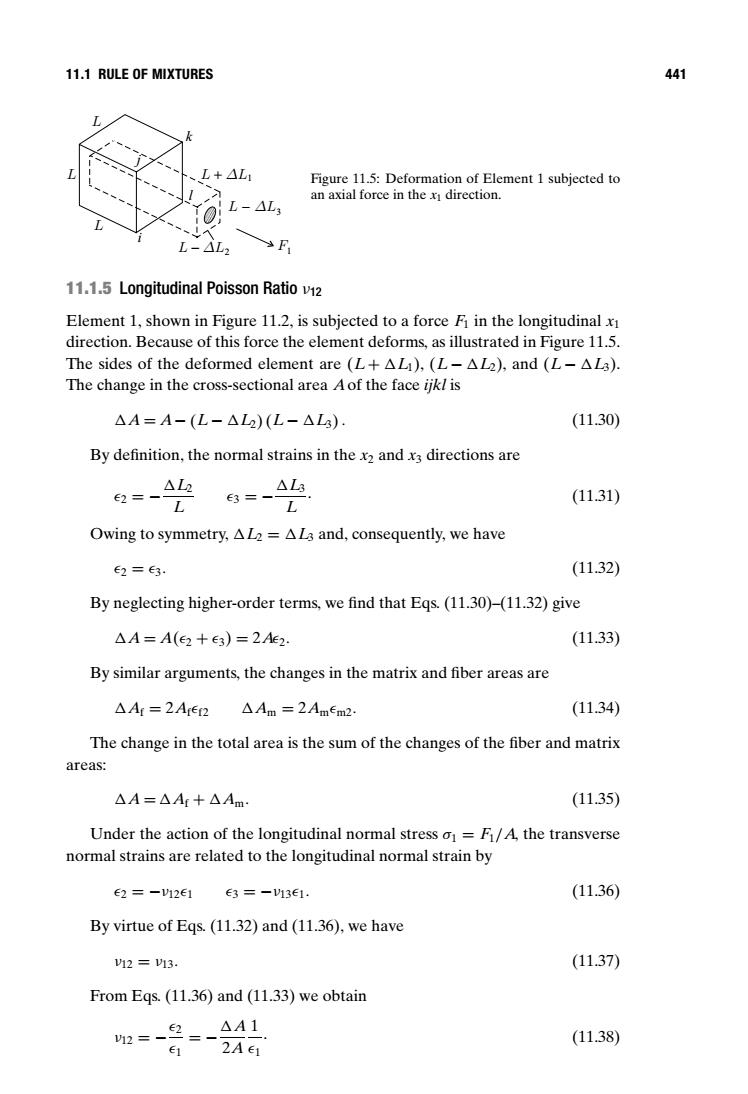正在加载图片...

11.1 RULE OF MIXTURES 441 L+△L1 Figure 11.5:Deformation of Element 1 subjected to an axial force in the x direction. L-△L L-△L 11.1.5 Longitudinal Poisson Ratio v12 Element 1,shown in Figure 11.2,is subjected to a force Fi in the longitudinal x direction.Because of this force the element deforms,as illustrated in Figure 11.5. The sides of the deformed element are(L+△Li),(L-△L2),and(L-△Ls). The change in the cross-sectional area A of the face ijkl is △A=A-(L-△L2)(L-△L3) (11.30) By definition,the normal strains in the x2 and x3 directions are L2 2=-L 3=- △L (11.31) Owing to symmetry,AL2 =AL3 and,consequently,we have E2=e3. (11.32) By neglecting higher-order terms,we find that Egs.(11.30)-(11.32)give △A=A(2+∈3)=2Ae2. (11.33) By similar arguments,the changes in the matrix and fiber areas are △Ar=2Are2 △Am=2Amem2: (11.34) The change in the total area is the sum of the changes of the fiber and matrix areas: △A=△A+△Am· (11.35) Under the action of the longitudinal normal stress o1 F/A,the transverse normal strains are related to the longitudinal normal strain by e2=-112e1 e3=-13e1. (11.36) By virtue of Egs.(11.32)and (11.36),we have 12=13 (11.37) From Eqs.(11.36)and (11.33)we obtain z=-2=-A41 2AE1 (11.38) E111.1 RULE OF MIXTURES 441 F1 L L + ∆L1 L − ∆L2 L L i j k l L ∆– L3 Figure 11.5: Deformation of Element 1 subjected to an axial force in the x1 direction. 11.1.5 Longitudinal Poisson Ratio ν12 Element 1, shown in Figure 11.2, is subjected to a force F1 in the longitudinal x1 direction. Because of this force the element deforms, as illustrated in Figure 11.5. The sides of the deformed element are (L+
L1), (L−
L2), and (L−
L3). The change in the cross-sectional area Aof the face ijkl is
A = A− (L−
L2) (L−
L3). (11.30) By definition, the normal strains in the x2 and x3 directions are 2 = −
L2 L 3 = −
L3 L . (11.31) Owing to symmetry,
L2 =
L3 and, consequently, we have 2 = 3. (11.32) By neglecting higher-order terms, we find that Eqs. (11.30)–(11.32) give
A = A(2 + 3) = 2A2. (11.33) By similar arguments, the changes in the matrix and fiber areas are
Af = 2Aff2
Am = 2Amm2. (11.34) The change in the total area is the sum of the changes of the fiber and matrix areas:
A =
Af +
Am. (11.35) Under the action of the longitudinal normal stress σ1 = F1/A, the transverse normal strains are related to the longitudinal normal strain by 2 = −ν121 3 = −ν131. (11.36) By virtue of Eqs. (11.32) and (11.36), we have ν12 = ν13. (11.37) From Eqs. (11.36) and (11.33) we obtain ν12 = −2 1 = −
A 2A 1 1 . (11.38)